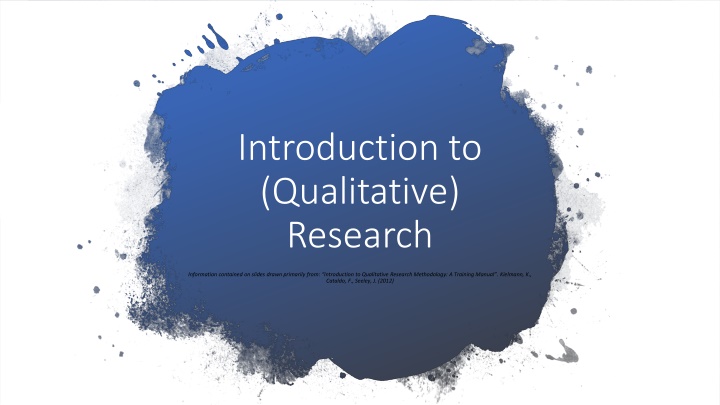
Qualitative Research: Methods and Importance
Explore the essence of qualitative research, its methods, and significance in understanding human experiences, beliefs, and behaviors. Learn how qualitative research complements quantitative data and adds depth to studies by uncovering emerging trends and issues often overlooked by traditional research methods.
Download Presentation

Please find below an Image/Link to download the presentation.
The content on the website is provided AS IS for your information and personal use only. It may not be sold, licensed, or shared on other websites without obtaining consent from the author. If you encounter any issues during the download, it is possible that the publisher has removed the file from their server.
You are allowed to download the files provided on this website for personal or commercial use, subject to the condition that they are used lawfully. All files are the property of their respective owners.
The content on the website is provided AS IS for your information and personal use only. It may not be sold, licensed, or shared on other websites without obtaining consent from the author.
E N D
Presentation Transcript
Introduction to (Qualitative) Research Information contained on slides drawn primarily from: Introduction to Qualitative Research Methodology: A Training Manual . Kielmann, K., Cataldo, F., Seeley, J. (2012)
What is qualitative research & when would we use it?
What is qualitative research? A type of scientific research not better than quantitative, but different Seeks to answer a question Uses a tool to answer a question Collects information from people This information is analyzed Produces findings- to tell us something about our question
Qualitative Methods .use more flexible and open-ended tools to explore and understand the experiences, beliefs, opinions, perceptions, values and behaviors from a smaller number of respondents. It offers depth and explanation for how events are experienced
Quantitative Qualitative Instruments are more rigid elicit and categorizes responses to questions Instruments are more flexible, and use an iterative style of eliciting and categorizing information General Framework Uses highly structured methods such as questionnaires and surveys Uses semi-structured methods such as in-depth interviews, focus groups and observations Closed-ended Open-ended Question Format Numerical Textual Data Format To quantify variation To describe variation To describe and explain relationships To describe individual experiences To describe group norms Analytical Objectives To describe characteristics of a population Study design is stable from beginning to end Participant responses to not influence what questions are asked next Some aspects of the study are flexible Participant responses affect how and which questions are asked Flexibility in Study Design
Why Use Qualitative Research? Understand the local context Investigate perceptions of a problem Complement quantitative information Add depth and richness to studies Contribute stories of human experience to illustrate statistics Identify emerging issues/ trends Identify issues unanticipated by the researcher
3 main qualitative methods Focus Group Discussions Individual (in-depth) Interviews Observation
What does qualitative data look like? Audio recordings Transcripts Field notes
Non Participant Observation Non Participant Observation Strengths Weaknesses Types of questions it can help to answer:
Focus Group Discussions Focus Group Discussions Strengths Weaknesses Types of questions it can help to answer:
Individual Interviews Individual Interviews Weaknesses Strengths Types of questions it can help to answer:






















